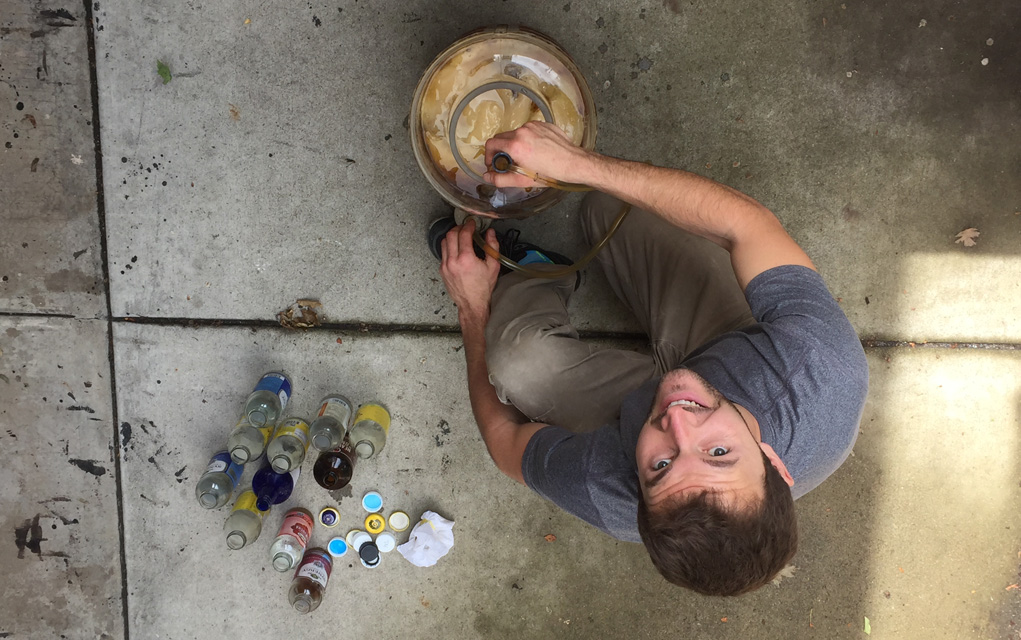
For my 22nd birthday, my college roommate gifted me a jar of gourmet kimchi. This was after I’d decorated our fireplace mantel with eight jars of fermenting kombucha, had stunk up our fridge with my own failed kimchi project, and regularly blended raw eggs in my smoothies.
By the world’s standards, I’m not that original. Roughly a third of the food eaten around the globe is fermented. Between alcohol, bread, cheese, sauerkraut, yogurt, kimchi, hot sauce and kombucha, it’s easy to see why: The transformation that food undergoes when left to party with certain bacteria often results in unique and defining cultural delicacies. But when I decided to convert my new 550-square-foot apartment’s kitchen into a fermentation lab, I was grateful my new roommate Jordan, my boyfriend of nearly three years, was on board.
We talked to John Wilson, Jordan’s old chemistry lab partner, who co-authors the blog “Fermentation on the Fringe” from his home near Fort Collins. He recommended to us The Art of Fermentation, by Sandor Katz, an internationally acclaimed “fermentation revivalist.” Katz put our new hobby in simple terms: “Fermentation is the transformation of food by various bacteria, fungi and the enzymes they produce.”
Our first project was kombucha, the bubbly, vinegar-like fermented tea. To start a batch, we needed a starter culture — what’s called a “scoby,” an acronym for symbiotic culture of bacteria and yeast. I got one from my friend in Colorado Springs, who got her’s in exchange for attending a circus class taught by a man she’d met at a coffee shop.
The fleshy, beige scoby basically acts as a house for a variety of bacteria and yeasts to hang out and procreate. We brewed a strong, pure black tea, dissolved sugar (to feed the bacteria), and then added the culture. The scoby grew to fill the tea’s entire surface area, providing a seal to protect the copper-colored liquid down below from rogue, undesirable bacterias in the air. Next we started batches of sauerkraut, yogurt, kimchi and pickled jalapenos.
When I tell Wilson — who is pursuing a degree in Colorado State University’s 4-year-old Fermentation Science and Technology program — about our forays into home fermentation projects, he laughs and says, “That’s the thing about it, you get really into it once you get past the hardest hurdle: convincing yourself you’re not going to kill yourself.”
Historically, fermented foods haven’t been popular in the U.S., especially compared to other cultures around the world, mainly because of the negative stigma attached to bacteria, Wilson says. “Being able to suspend the belief that, ‘If it’s not perfectly sterile, we shouldn’t eat it,’ is hard in a society that tells us to sanitize everything.”
But bacteria are actually vital to our well-being.
“We have trillions and trillions of bacteria that live in our intestines,” says Dr. Tiffany Weir, a professor at CSU who researches how food affects our gut microbes. “And they’re not there by accident. The’ve been there since the beginning of time and have evolved specific functions that we wouldn’t be able to do without them.”
Many foods, most plants for example, we can’t digest on our own, she explains. “Gut bacteria actually break down fibrous plant matter, use it for their own energy, and in the process, they make other compounds that our bodies can use too.”
Many of these healthy gut bacteria are replenished and fortified by the microorganisms alive in fermented foods. “Many of the species found in fermented foods are either identical to or share physiological traits with species relevant to promoting GI tract health,” writes Weir in a paper she recently co-authored, “Health benefits of fermented foods: microbiota and beyond.”

Thus, she says, eating fermented foods can be an extremely healthy habit.
For Katz, fermenting your own food is taking a stand against the over-processed food economy.
“Reclaiming our food and our participation in cultivation,” he writes, “is a means of cultural revival, taking action to break out of the confining and infantilizing dependency of the role of the consumer, and taking back our dignity and power by becoming producers and creators.”
Katz’s attention to the “art” of fermentation is a tribute to the cultural backbone that fermentation provides for many cuisines around the world. He implies it’s no coincidence that we call the starters used to initiate fermentation “cultures,” the same word for human communities. Katz writes, “Fermentation is more dynamic and variable than cooking, for we are collaborating with other living beings.”
From the North Pole, all the way down to the equator, people thousands of years ago learned how to manipulate the fermentation processes that they noticed occurring in the wild in order to selectively preserve their food finds. In tropical climates, fermentation allows people to keep foods like fish for weeks, despite spoiling heat. At more northern latitudes with harsh winters, fermented foods like sauerkraut will carry nutrients to the community throughout the winter when fresh food is in short supply.
Because fermentation is often a multi-step, multi-day process, it tends to draw people together in the making. “Food is the only thing that is truly universal in humanity. Even psychopaths have to eat,” Wilson says. “Fermentation is making human connections. It’s an intimate thing. You’re working with your hands, directly touching the food. And when you share fermented foods, particularly something that’s never been eaten before, you need trust — that it’s not going to make you sick or kill you.”
The surge in gut health research over the past decade has contributed to fermented products “going more mainstream recently,” Weir says. “This isn’t new, necessarily. Science is just finally catching up and supporting what people have known for a long time through folk medicine.”
She remembers drinking kombucha as a kid, “but it was something the neighbors gave you — not something you bought at the store.”
Our sugary tea and scoby mix sat under the dining table for 10 days. I watched as a film slowly developed across the surface, thickening a bit each day. The scoby was growing, doing its job. According to Katz, it’s safe to drink after at least a week. But we wanted to be sure. Instead of rebottling and letting it sit longer in the fridge, allowing the bacteria to feast on a second helping of sugar and carbonate the drink, we decided to leave it in its original state and share it with friends later that night.
As it grew dark outside, our friends piled in, sitting cross-legged on our hardwood floor. I siphoned off the gurgling amber liquid, pouring a few inches in each glass, praying it would be drinkable. I tried not to imagine my friends passing out from some perverted strain of bacteria.
The kombucha made its rounds — vinegary, almost apple-cider-like — as we all sipped and laughed. In my head, I heard Wilson say: “Fermented products are a leap of faith in the community that you’re in.” I’m relieved we stayed alive long enough to enjoy three bottles of fermented grapes, too.














